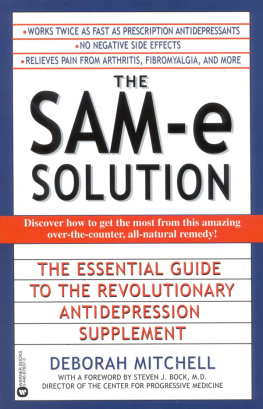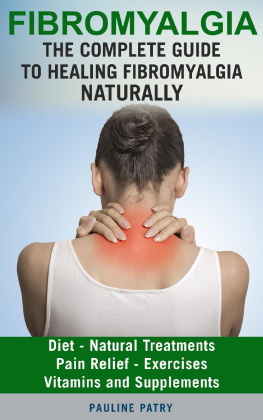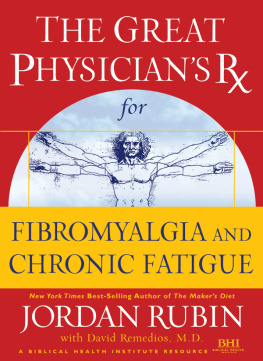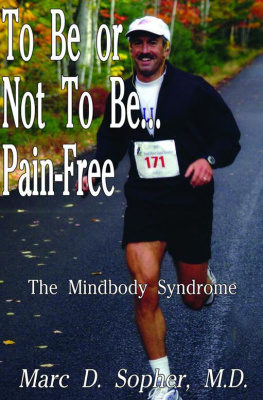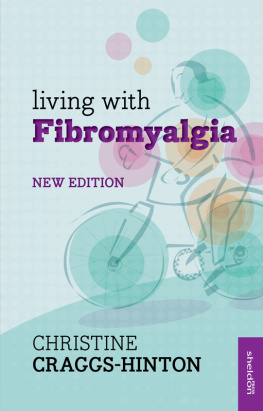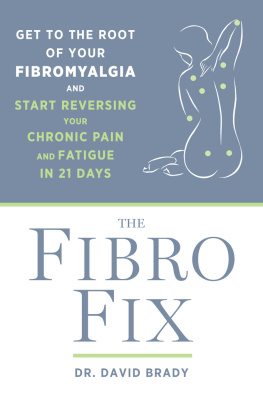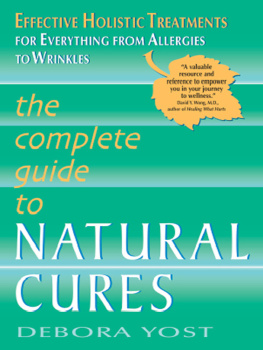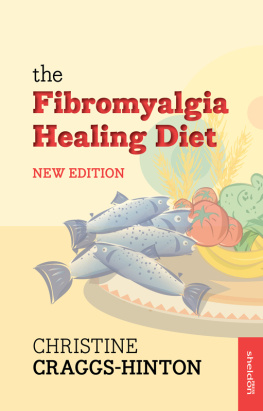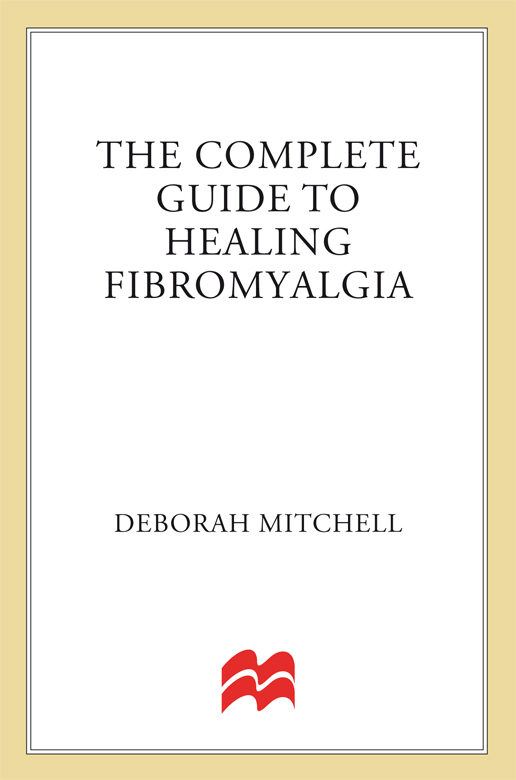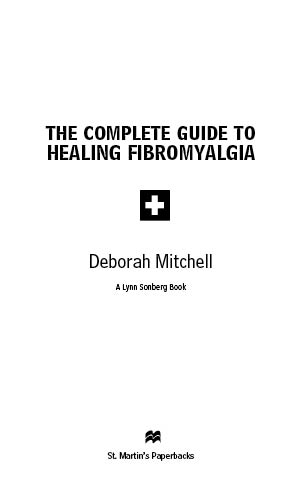
CONTENTS
INTRODUCTION
Millions of people in the United States and millions more around the world wake up each day feeling as if they had not slept and knowing that the pain they feel as they get out of bed will stay with them the rest of the day, and the day after that, and on and on.
They suffer from a medical condition called fibromyalgia. Some people with the condition will be too fatigued to make breakfast for their children or be in too much pain to lift their infants into a high chair. Young men and women in their career-building years may be unable to continue going to work and may face the likelihood of disability. Couples who once enjoyed socializing, going on vacations, playing with their children, and making love find that the chronic pain, joint stiffness, uncertainty of bowel problems, and overwhelming fatigue experienced by one of them has greatly stressed their relationship. Otherwise healthy-looking men and women who once jogged and swam and played tennis now find it an athletic event to walk to the end of their driveway.
Not so long ago, people who lived with these debilitating symptoms were told it was all in their head, that they were imagining things, or even that they were crazy. If they could find a doctor who would listen and who was sympathetic, they might get a variety of drugs that did little or nothing to relieve their pain or the many other symptoms they were experiencing.
Thank goodness those days are over.
The good news is that the medical profession, the scientific community, and the pharmaceutical industry now recognize fibromyalgia as a legitimate condition. That means patientsmost often women, because 80 percent of those with fibromyalgia are femaleare much more successful at finding medical assistance; that research into the causes, prevention, and treatment of fibromyalgia is actively being pursued; and drug companies, seizing an opportunity, are developing prescription medications.
There is more good news. Although the symptoms of fibromyalgia are many and often serious, a growing number of people with the syndrome are finding effective ways to combat them. Some people turn to conventional approaches while others choose alternative and complementary therapies. This book offers you information and choices from both sides of the aisle and also discusses what many people with fibromyalgia are learning for themselves: combining conventional and complementary therapies is often the best way to fight this disease.
As Vera, a thirty-one-year-old fibromyalgia patient noted at a support group gathering, When I first began researching all the different ways to treat fibromyalgia, I got anxious because I thought there were way too many choices. Then I realized that having many possibly effective options was a good thing. Imagine if there were only three or four treatments and none of them worked for me. Then what would I do? I actually feel empowered by having so many choices. I found what I call the three Ms that work for me: medication, massage, and MSM [a natural supplement]. Oh yes, and my support group, which is a huge help as well. Veras story is not unusual: you, too, can find relief from fibromyalgia if you are willing to embrace the options available to you and find those that are most suited to your needs and lifestyle.
When compared with other health challenges that can be as debilitating as fibromyalgia is for so many people, our understanding of this syndrome is in its infancy. Diagnosis can be a very long process, often taking years from the time an individual reports symptoms to when a doctor finally identifies the syndrome. Once the syndrome is diagnosed, there are only three FDA-approved drugs specifically for fibromyalgia, although there are many other medications healthcare providers can prescribe for off-label use to treat the symptoms, and also many more natural and alternative and complementary options.
This book explores what we know about fibromyalgia and how individuals with the syndrome can live their lives to the fullest. In these pages you will find the most up-to-date information on diagnosis, including the new preliminary diagnostic guidelines (2010) from the American College of Rheumatology, as well as many treatment options from both the conventional and complementary realms, and suggestions on ways to improve quality of life.
HOW TO USE THIS BOOK
The book is divided into two main sections. The four chapters that make up Part 1 explore the syndrome of fibromyalgia: what it is and what it is not; a detailed evaluation of its signs and symptoms, and what they mean to people who live with fibromyalgia; how to find healthcare providers to help you get a diagnosis and treatment; and what the process of getting a diagnosis includes. These chapters help fibromyalgia patients understand the role they can play in getting a diagnosis and choosing treatment options.
Then in Part 2, Take Charge of Your Life With Fibromyalgia, readers learn about all the options they have now that they have a diagnosis. The chapters in this section explore medications and other conventional treatments, natural supplements and herbal remedies, alternative/complementary therapies, different types of movement and exercise therapies, the role of diet in fighting fibromyalgia, the value of support systems and how to utilize them, and how to handle everyday activities and responsibilities when you have fibromyalgia, including what to do when you travel, how to restore your sex life, how to cope with motherhood, what to do about work and disability, and how to learn new sleep habits.
Having fibromyalgia changes livesthe lives of the people with the syndrome and those of their loved ones. This book is for all of you.
PART I
Fibromyalgia: The Syndrome
CHAPTER ONE
An Introduction to Fibromyalgia
I wish I didnt feel so exhausted and in pain all the time.
Its a struggle to even get out of bed in the morning. I have kids to take care of, but I cant even get it together to make breakfast half the time.
I used to have a great job, and then I had to quit because the fatigue and the lack of concentration made it impossible for me to keep working.
I dont know which is worse, the fatigue or the depression or the pain. All I know is, Im sick and tired of feeling sick and tired.
Do any of these statements describe you? If so, you may be one of the millions of people in the United States who is living with fibromyalgia. We say millions because it is difficult to obtain an accurate number of people who have fibromyalgia. Depending on the source, the numbers range from 6 to 12 million. According to the Mayo Clinic, for example, 2 percent of the American population has the syndrome, which places the figure at around 6 million. The National Fibromyalgia Association estimates the number to be 10 million in the United States and that this syndrome affects 3 to 6 percent of the worlds population. If you check with WebMD, a popular Web site among Internet surfers looking for health-related information, you will see the high figure of 12 million Americans.
Why is there such a large range in estimates? One reason is that fibromyalgia is difficult to diagnose; another is that it can take several years of going to doctors before an individual is finally given a diagnosis. Many cases are believed to go unreported or undocumented because some people just give up seeking a medical reason for their symptoms. Quite simply, they are sick and tired of being sick and tired, and that no one can seem to tell them why.


